Hill 62 Canadian Memorial is one of Canada’s thirteen First World War Memorials erected to honour and remember the achievements and sacrifices of Canadians and Newfoundlanders during the First World War. The memorial stone, set in a large circle of green lawn at the top of three landscaped terraces, bears the following inscription:
Here at Mount Sorrel on the line from Hooge to St. Eloi, the Canadian Corps fought in the defence of Ypres April – August 1916
Hill 62 Canadian Memorial stands in tribute to the sacrifices and achievements of Canadian soldiers in bloody actions fought over a period of five months to keep a determined enemy from gaining possession of the last few square kilometres of Belgian territory that was still in Allied hands.
From the top of the steps leading up to the Hill 62 Canadian Memorial, looking down past Sanctuary Wood and Maple Copse along the broad spur of Observatory Ridge, one can see the church towers of Ieper, five kilometres to the west.
Before the commemorative ceremony started, a group of English school children came to visit this monument.

The Canadian Armed Forces guard, is for the Memorials in Belgium, a 70-person guard comprised of the units that fought during the Battle of Passchendaele (selected based on their unit's connection to the battle and merit).
The units perpetuating those that fought or supported the Battle of Passchendaele:
- 48th Highlanders
- 56th Field Artillery Regiment, through its perpetuation of Dufferin and Haldimand Rifles
- Algonquin Regiment
- Argyll and Sutherland Highlanders
- British Columbia Dragoons
- Calgary Highlanders
- Cameron Highlanders of Ottawa
- Canadian Grenadier Guards
- Canadian Scottish Regiment
- Cape Breton Highlanders
- Essex and Kent Scottish
- Grey and Simcoe Foresters
- Governor General's Foot Guards
- Hastings and Prince Edward Regiment
- Irish Regiment of Canada
- Lake Superior Scottish
- Les Fusiliers Mont-Royal
- Le Régiment de Maisonneuve
- Les Voltigeurs de Québec
- The Loyal Edmonton Regiment
- The North Saskatchewan Regiment
- Nova Scotia Highlanders
- Princess Louise Fusiliers
- Princess of Wales' Own Regiment
- The Royal Regiment of Canada
- The Royal Regina Rifles
- The Royal Westminster Regiment
- The Royal Winnipeg Rifles
- The Toronto Scottish Regiment
- The King's Own Calgary Regiment
- The Queen's York Rangers
- The Saskatchewan Dragoons
- The Sherbrooke Hussars
- The South Alberta Light Horse
- The West Nova Scotia Regiment
- Princess Patricia's Canadian Light Infantry
- Queen's Own Cameron Highlanders of Canada
- Queen's Own Rifles of Canada
- Rocky Mountain Rangers
- Royal 22e Régiment
- Seaforth Highlanders of Canada
- Stormont, Dundas and Gelngarry Highlanders
- The Black Watch
- The British Columbia Regiment
- The Fort Garry Horse
- The Governor General's Horse Guards
- The Halifax Rifles
- The Lincoln and Welland Regiment
- The Lorne Scots
- The North Shore (New Brunswick) Regiment
- The Ontario Regment
- The Royal Canadian Regiment
- The Royal Canadian Hussars
- The Royal Hamilton Light Infantry
- The Royal Highland Fusiliers of Canada
- The Royal Montreal Regiment
- The Royal New Brunswick Regiment
- The Royal Newfoundland Regiment
Handing out the weapons

The Catafalque Party arrived



Arrival of the Canadian Armed Forces band, La Musique du Royal 22e Régiment. Since its formation in 1922, it has enjoyed world-class notoriety. Its reputation is due entirely to the musicians who have been part of the ensemble since its formation. It now consists of 38 members, all of whom have a true passion and devotion for music. Many are graduates of Canadian and foreign universities and conservatories. La Musique du Royal 22e Régiment is the only professional military band of the Province of Quebec.

The Canadian Armed Forces guard arrived

Parliamentary Secretary Mrs. Sherry Romanando, accompanied by Lieutenant General Juneau, proceeded to the front of the guard to receive the General Salute


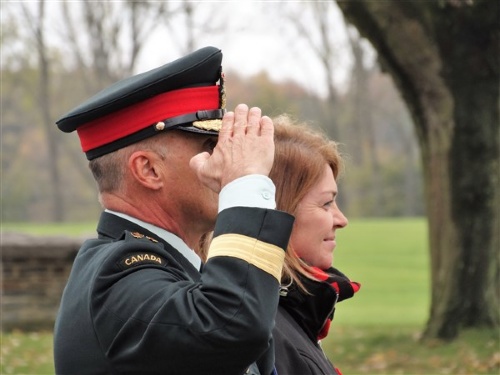
Speech by Mrs. Sherry Romanando, Parliamentary Secretary to the Minister of Veterans Affairs and Associate Minister of National Defence

Presentations of research projects by the youth of Canada. Like you may read in the post of the commemorative service at the Brooding Soldier, these children have all family who fought during the Battle of Passchendaele.
Madison Barrow
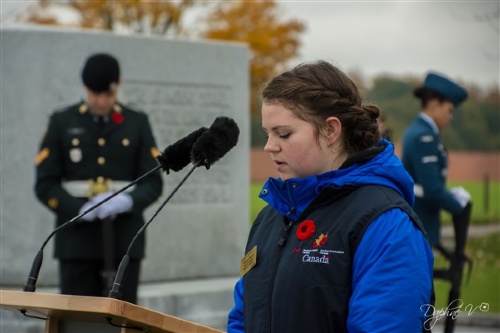
Ben Jamieson
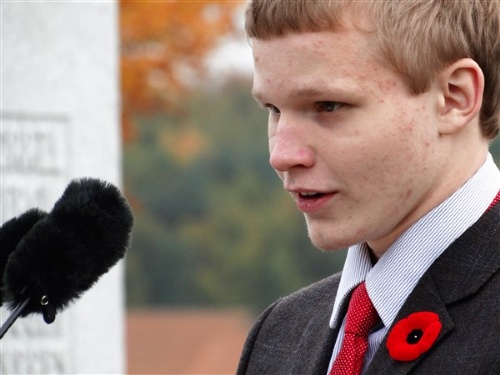
Kiera Wortley
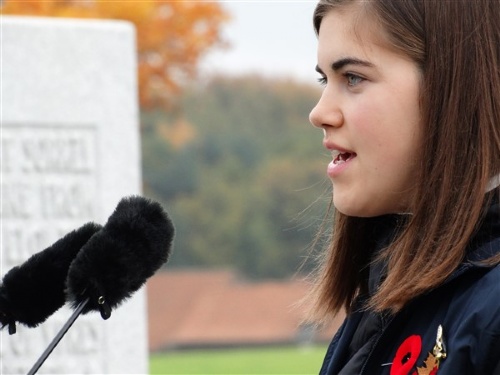
Prayers by Lt Zbigniew Jonczyk, Canadian Armed Forces padre
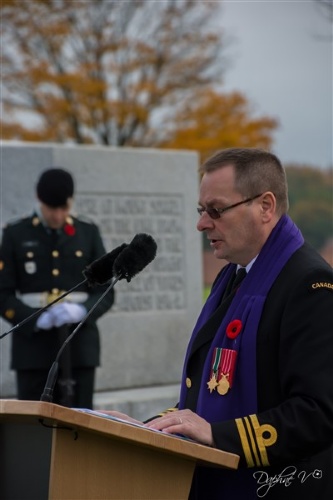
Indigenous blessing by Elder Steven Ross
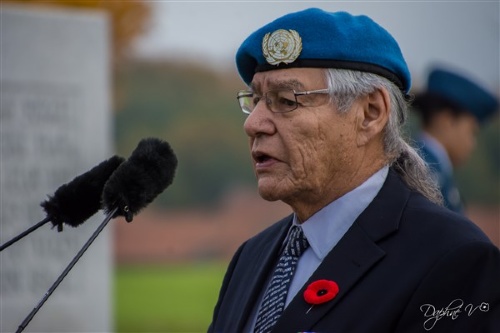
Act of Remembrance by
Russel Smart (English)
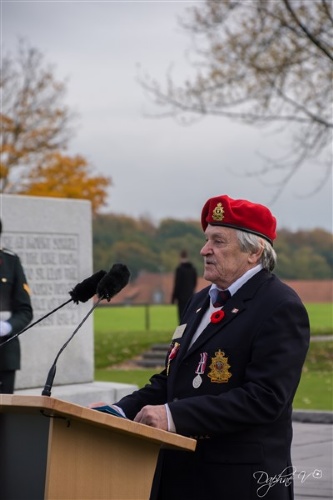
Luc Tremblay (French)

Luc O'Bomsawin (Abénakis)
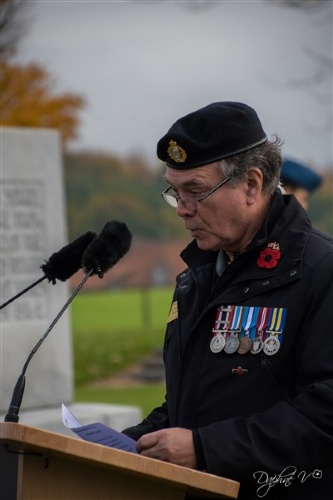
Commitment to Remember by
Madison Barrow (English)
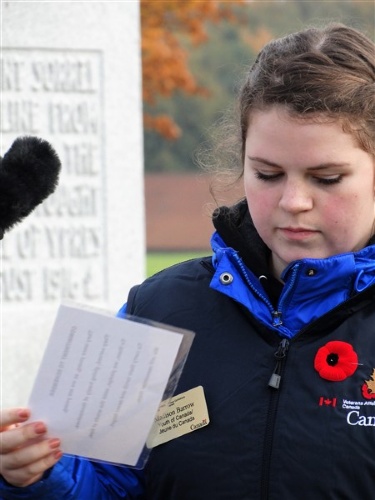
Gérémy Côté (French)

Teghan Angulalik (Innuinaqtun)

Diederik Dujardin (Dutch)
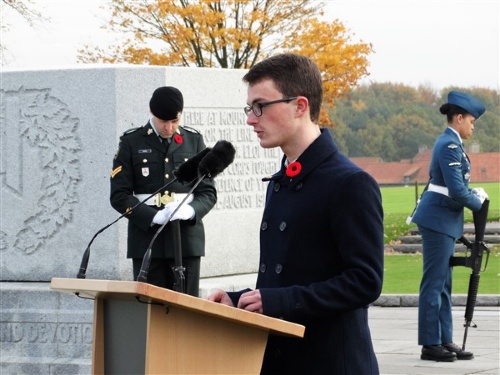
Last Post, One Minute of Silence, Rouse


Lament

Wreath Laying
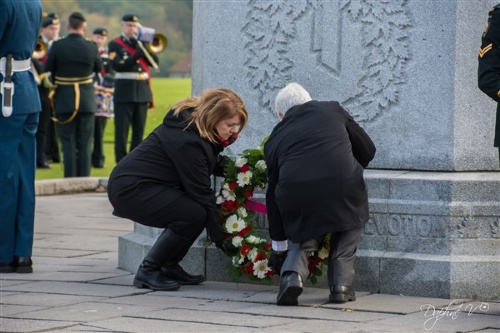
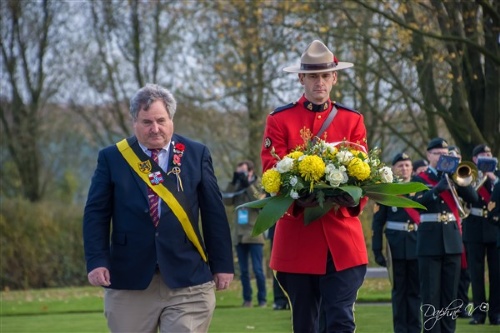

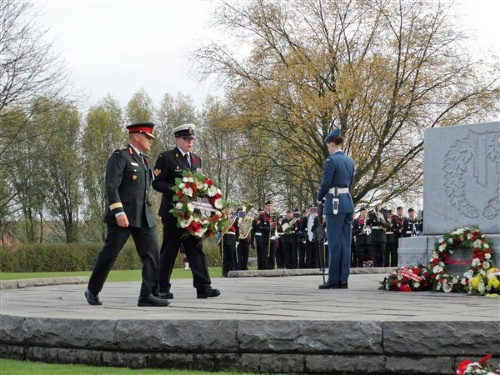






National Anthems


Mrs. Sherry Romanando and Lieutenant General Juneau proceeded to the front of the guard to recieve the General Salute before departing

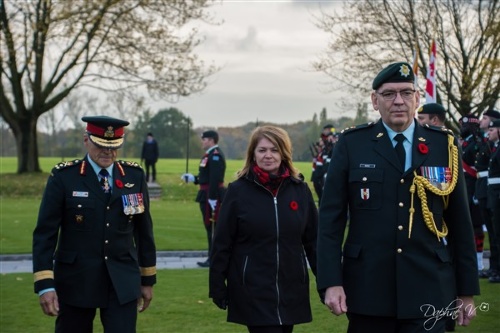
The Band and Guard of the Canadian Armed Forces marched off





Group picture with on the left the grandchildren of Francis pegahmagabow: Julie Pegahmagabow and Brian McInnes. Westtoer, with the support of the province of West-Flanders and the Flemish governement, invited two offspring out 7 contries to commemorate their family member 100 years later. For Canada the choice fell on the grandchildren of Pegahmagabow.
He was probably born on March 9, 1889 at Parry Sound, Canada. After the early dead of his parents, he was raised by tribal members.
Following the outbreak of World War I, Pagahmagabow volunteered for service with the Canadian Expeditionary Force in August 1914, despite Canadian government discrimination that initially excluded minorities.
He woudl eventually become the higest decorated Canadien soldier of indigenous descent and is also one of the 38 Canadians who got a Military Medal with 2 bars.
He received the Military Medal for carrying messages along the lines under heavy artillery fire at Ypres, Festubert and Givenchy.
He earned his first line in the Third Battle of Ypres, for maintaining contact with the flanks on the night of November 6/7, 1917. His second bar followed in August 1918 during the Battle of Scarpe, France.
Further more he was also an excellent sniper with no less than 378 confirmed kills.
He survived the war and became an activist for the rights of the indigenous people.

Interview with Mr. Jef Verschoore, Alderman town of Ypres

The Catafalque Party dismounted

Collection of the arms of the guard of the Canadian Armed Forces

Page made by IDG and Daphné Vangheluwe